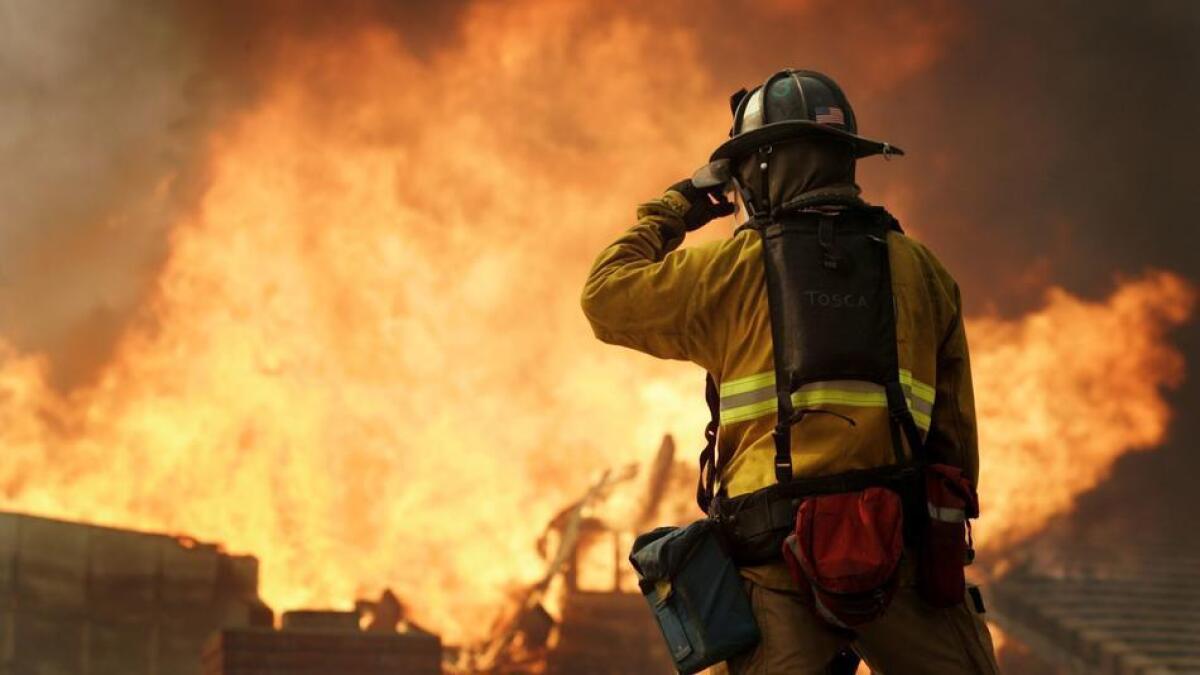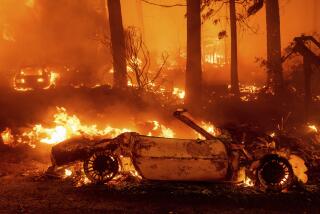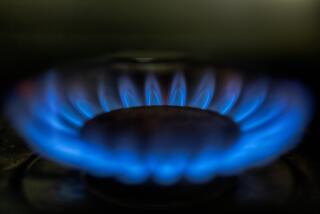San Diego utility goes to court in bid to shift $379 million in wildfire costs to customers

San Diego Gas & Electric is not giving up its fight to pass on to ratepayers $379 million in costs related to the deadly wildfires that scorched the San Diego area 11 years ago.
The utility has filed an appeal with the state’s 4th Appellate District in San Diego, calling on the court to review a decision by the California Public Utilities Commission that rejected SDG&E’s request last November. The commission also denied the utility a rehearing on the case last month.
SDG&E’s attorneys said last year’s decision “will have severe adverse practical consequences for privately owned utilities” in California and, by extension, threatens to have “ripple effects throughout the state’s economy.”
The CPUC has put utilities in a “whipsaw,” the 84-page filing argued. SDG&E wants the appeals court to vacate the commission’s 5-0 vote and “rule that SDG&E is entitled to recover payments” from the 2007 San Diego wildfires.
San Diego attorney Michael Aguirre, who represented ratepayer advocate Ruth Henricks on behalf of utility customers in a lawsuit dealing with the 2007 fires and is a sharp critic of SDG&E, doubted the appeals court would take the case.
“They defer to the [CPUC] agency unless the agency did something gravely wrong,” Aguirre said. “SDG&E received very fair treatment by the CPUC and there’s really no basis for this. This is really an act of desperation.”
Aguirre said parties to the case and the CPUC would respond to SDG&E’s filing and eventually the appeals court will decide whether to hear the case or not.
Terrie Prosper, director of the News and Outreach Office at the CPUC, said in an email to the Union-Tribune the commission will “respond in due course” to SDGE’s court filing.
SDG&E spent $2.4 billion to resolve more than 2,000 lawsuits related to the Witch, Guejito and Rice wildfires but the utility insists the blazes were ignited by factors beyond its control — including extreme Santa Ana winds, a lashing wire owned by Cox Communications that hit an SDG&E power line and a tree limb that fell onto an SDG&E line due to high winds.
“The CPUC committed numerous legal errors including a failure to follow its own legal standards for assessing the reasonableness and prudence of utility management decisions and the application of a perfection standard that depends on hindsight bias,” said SDGE spokeswoman Allison Torres in part of a statement.
But the CPUC saw it differently.
Acting on a proposed decision reached by a CPUC administrative law judge, all five commissioners turned down SDG&E’s request, saying the utility failed to meet the commission’s “prudent manager” standard.
The CPUC concluded that the winds in October 2007 were not unprecedented and SDG&E should have foreseen the impact of the gusts that spread the wildfires that destroyed more than 1,300 homes, killed two people, injured 40 firefighters and forced more than 10,000 to seek shelter at Qualcomm Stadium.
The SDG&E filing argued there is “substantial evidence” that the power company acted responsibly and the CPUC’s application of the prudent manager standard was “legally erroneous.”
The utility pointed out that the Federal Energy Regulatory Commission, which regulates interstate transmission rates, granted SDG&E settlement payments through rates that eventually came to $80 million and found “the record indicates SDG&E behaved as a reasonable, prudent utility in the maintenance of its lines prior to the wildfires.”
A large part of SDG&E’s case turns on the legal doctrine known as inverse condemnation. As interpreted by courts in California, inverse condemnation holds that utilities can be held liable for damages related to a wildfire ignited by a power company’s equipment — such as a downed power line — even if the utility followed accepted safety procedures.
Utilities say such an interpretation, combined with the requirement that power companies provide electricity in areas at risk to wildfires, may lead them to bankruptcy.
Defenders of inverse condemnation say the way it’s applied in California gives power companies extra incentive to reduce wildfire risks in their service territories and take extra precautions that their equipment and procedures don’t spark conflagrations.
The SDG&E appeal comes as a number of wildfires rip through the Golden State. Five of the 20 most destructive fires recorded in California occurred in 2017 and this summer’s Mendocino Complex Fire was recently pronounced the largest wildfire in state history, burning more than 378,000 acres. As of Saturday, the massive fire was 76% contained.
Lawmakers in the final two weeks of the legislative session in Sacramento were considering several laws dealing with wildfires, including Gov. Jerry Brown’s draft legislation that would have altered the way inverse condemnation is applied. The state’s large investor-owned utilities, including SDG&E, maintain that the existing liability rules are too onerous and costly.
But on Saturday the leader of the negotiations on crafting a new liability standard for utility companies said lawmakers had abandoned efforts to loosen the rules.
Nikolewski writes for the San Diego Union-Tribune.
rob.nikolewski@sduniontribune.com
More to Read
Start your day right
Sign up for Essential California for news, features and recommendations from the L.A. Times and beyond in your inbox six days a week.
You may occasionally receive promotional content from the Los Angeles Times.






